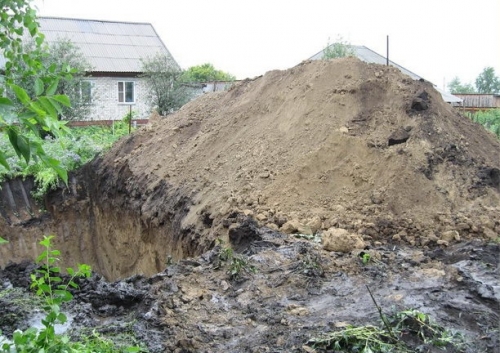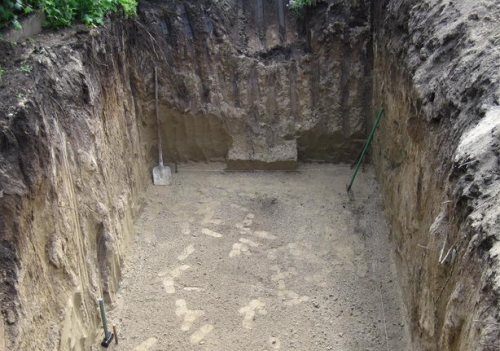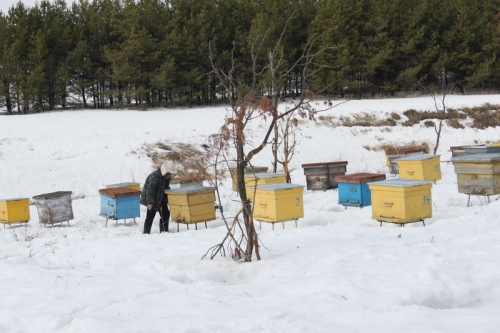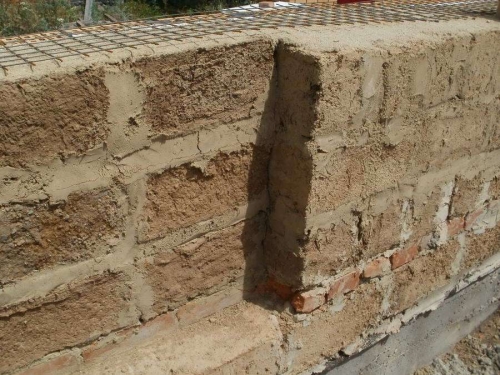To build a truly heat-efficient house, you need to take care of insulation not ...
|
|
Many owners of apartments in multi -storey buildings live in conditions of square deficiency ... |
The arrangement of the garage from the sandwich panels has a mass of advantages, among which ... |
Omshanik for bees: how to build a honey wident for bees

An important point in bee dilution is arranging a safe place for wintering, which will protect honey plants from temperature fluctuations and gusts of wind. In regions with harsh, frosty and prolonged winters, the only way to protect bee families to hive up in Omshanik.
Consider the requirements that are nominated before the winter workers, the features of different types of omsariks and give a step -by -step briefing on the construction of shelter for bees.
Content
- The necessity and advantages of using omsor for wintering bees
- Basic requirements for bees
- Types of Omshans and their features
- An example of calculating Omshanik
- Winter ventilation
- How to build an oxide for bees
- Hives placing hives in mshanik
The necessity and advantages of using omsor for wintering bees
Omshanik (winter house) for bees a special room for sheltering bee families in the cold season. The bees in the Omshanik are at rest and do not react at all to temperature changes on the street.
It is impossible to do without mshanika when breeding bees in the northern regions with harsh weather conditions. In the central regions, the expediency of the construction of a winter road depends on the breed of bees. When keeping the bees of yellow, gray Caucasian, Carpathian and steppe Ukrainian breeds, it is necessary to equip a protected room. The Central Russian Bee breed is adapted to cold winters, so the hives can be on the street all year round.
Advice! In regions with an unstable climate (day +5C, at night -20C), weak bee families are best added to Omshasnik for the winter
Passic owners note a number of advantages of using winters:
- There is no risk of the death of a bee family due to sharp temperature changes.
- The life of the hives increases. Wooden equipment is not subjected to atmospheric sediment, so it rot less.
- Bees winting in the msman eat less food. On the one hand, it is saving money on feeding, and on the other, insects load the intestines less and will be more able -bodied during a honey collection.
Basic requirements for bees
In order to fully fulfill its protective functions, its design must meet the following requirements:
- Omshanik must accommodate at least 100 hives. In this case, it is easier to reach the optimum temperature in the room (from 0C to +3C).
- If the wintering room is designed for 300 hives and less, then in the structure one entrance should be provided from the southern or eastern side. For omsarrs with a larger area, it is necessary to make two exits located opposite each other.
- Winter doors must be insulated.
- The ends of the Omshanika should look south and north.
- The floor thickness is at least 20 cm. It is optimal if the base of the floor is made of gravel with clay, and sand from above.
- An important point of ventilation. The ducts can be built from boards. In the attic and from the side of the street, ventilation ducts must be insulated. The supply ventilation can be done in the wall by the floor, which is exhausted on the ceiling in the center of the Omshanik.
- The ventilation system should be adjustable.
- For the outflow of melt and rainwater, it is necessary to equip a divert of a ditch.
- The width of the steps is at least 100 cm.

- It must be dry in the wintering room. Dampness leads to acidification of honey and does not affect the health of bees. When excess humidity (more than 85%) appears, the room must be dried in the summer.
Types of Omshans and their features
All bee winterers are three types:
- underground;
- semi -underground;
- everse.
Underground omshaniki They are considered the best. The temperature in such rooms is most stable and does not depend much on weather conditions on the street. In addition, it is more convenient to adjust the humidity in underground ms. The design of the winter road goes back 2-3 meters, the ceiling is on the ground with the ground.
Underground Omshanik: photo
Half underground omshas It is advisable to build if groundwater is located shallow.
Important! The distance of the floor of the Omshanika before the groundwater falls should be at least 1 meter. Otherwise, the room will be damp
Everse Zimovnik It is built in extreme cases when the conditions of the terrain do not allow to build another type of msman. During construction, special attention should be paid to thermal insulation of the ceiling and walls.
The design of ground omshanik can be made of plank or double log walls, a layer of insulation should be more than 1 meter. As a thermal insulation material, straw, sawdust, chips, dry leaves or expanded clay are used.
An example of calculating Omshanik
Before the construction of Zimovnik, it is necessary to correctly calculate its size. A microclimate in the room will depend on the accuracy of calculations. The excess of the cubic meter will negatively affect the air temperature in the omsor to become colder, and due to lack of area, stuffiness and excess humidity will appear.
The volume of the wintering industry is calculated based on the number of hives, their design and possible expansion of the liability in the coming years. Single -walled hives occupy about 0.6 m3 rooms, sunbeds and double -walled hives 0.9 m3.
Let us give an example of calculating the omsor for 100 double -walled hives. Omshanik from the inside will be filled with racks located in three tiers: lower, middle and upper. Each tier will have two narrow racks (70 cm) located along the side walls. The third rack in the middle of the room will be double. It will accommodate two rows of hives. The width of the medium rack 160 cm, taking into account the interval between the rows of 20 cm. The passages between the racks are 90 cm, the gaps between the side walls and rows of hives 20 cm.
Knowing these data, you can calculate the width of the mshanik: 20+70+90+160+90+70+20 \u003d 520 cm. Thus, the required width of the oxide for placing a hundred hives is 5.2 m. The height of the winter road is standard 2.5 m.
We calculate the length of the mshanik based on the obtained parameters:
- the total volume of the room is 90 m3 (100*0.9);
- winter width is 5.2 m;
- building height 2.5 m.
So, the length will be: 90/(5.2*2.5) \u003d 6.92 m. This value can be rounded to 7 m.
Winter ventilation
The ventilation system of the msman can be organized in two ways.
First option.Installation of one pipe through which fresh air is supplied and spoiled outflow. The ventilation pipe comes from the ceiling of the structure and ends at the roof skate. In the winter season, such a system acts satisfactorily, but with the advent of spring ventilation, the danger of excessive increase in air temperature does not appear enough.
A single -pipe ventilation system is characteristic of old buildings.
The second option. A two -pipe ventilation system consisting of an supply and exhaust pipe. The supply pipe is installed at the floor level and supplies cold air spreading through the floor and rising up as it heats up. Exhaust pipes are mounted into the ceiling, pass through the attic and go over the roof (above the roof skate).
The ventilation system is made of polished, dry boards (thickness 35 cm), hermetically hermetic with each other. To regulate the gap of ventilation pipes, valves are installed.
Advice! To strengthen the drain force, the attic and external parts of the exhaust pipes must be made double, and the insulation is laid in the intervals
The cross -sectional area of \u200b\u200bthe supply/exhaust pipe is determined at the rate of 5 cm2 per bee family. For example, for mshanika for 100 hives, pipes with a section of 25*20 cm are suitable.
How to build an oxide for bees
Preparatory work: Choosing a place and materials
When choosing a site for construction, you must adhere to the following recommendations:
- Ground waters on the site should be at a depth of 3.5 meters from the surface and below. This rule is valid for underground ms. For terrestrial winters, this depth should be at least 1 meter.
- Omshanik is better to have near Pasiki.
- A small ravine or a hill slope is suitable for construction.
- Preference should be given to a place protected from the winds.
For the construction of a bee shelter, limestone, saaman, a trimming board, reed plates, humplings, etc. In an omsary made of adult, is retained normal humidity and constant temperature throughout the winter.
Advice! It is better not to use cement blocks for the construction of a wintering room. The material does not hold heat well
Step -by -step briefing of the construction of omshanik for bees with your own hands
Consider the sequence of construction of an underground omshan from bricks.
- On the site, mark the location of the winter road.
- Dig the pit under the msman. For work, you need to attract special equipment an excavator and a truck for transporting land.

- To align the bottom of the pit and walls.

- Cut the base under the future staircase.
- From the boards, build the formwork for the foundation.
- Pour concrete into the formwork. You can add large cobblestones.
- Put the walls out of brick.

- Each layer of masonry must be strengthened to fill the gaps between the bricks and walls of the pit with a layer of clay.
- Mount a metal bandage. Along the long walls, drive pipes at a distance from each other about 2 meters.
- Boil the elements of a metal strapping with ceiling crossbars (channel).
- Pour the ceiling slabs:
- Leave the ceiling plates to dry.
- Put the roofing material on the slabs.

- To equip a vestibule for mshanik, to mount ventilation pipes.
- Put the steps and install the front door.

Homemade semi -underground omshanik: video
Hives placing hives in mshanik
- Before transferring evidence to Omshanik, the room must be well ventilated and dried. The ceiling and walls of the winter road must be whitewashed with freshly cramped lime.
- With the onset of stable colds (early December), bees can be brought into shelter.
- More hardy and strong bee families are placed on the lower tier. If one tier is provided in the Omshanik, then the evidence with weak families is put away from the door.
- The founders must be opened after the evidence was transferred to the winter road and the bees completely calmed down.
- After skidding, ventilation must be strengthened by 2-3 days. This is due to the fact that condensate is formed on the hives and get rid of it as soon as possible.
Important! While visiting the winterber, you must behave very quietly. A muffled red light is suitable for lighting the room
Sunny bee hives in mshanik: video











